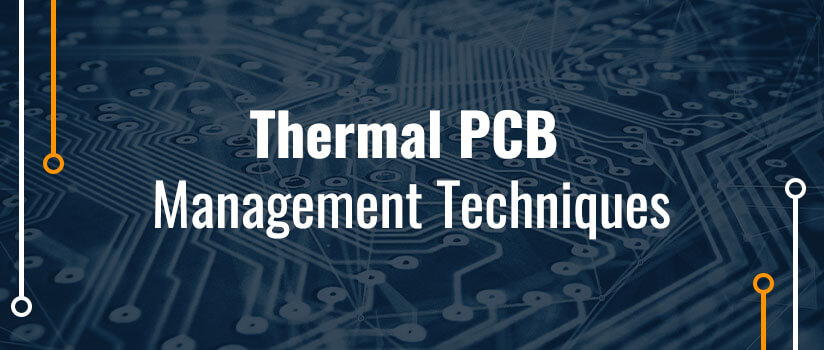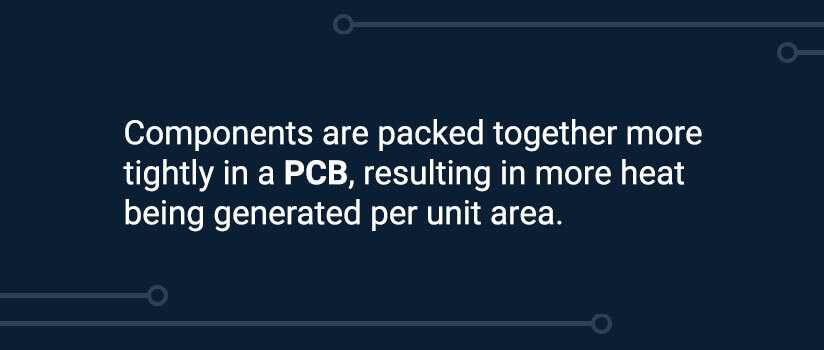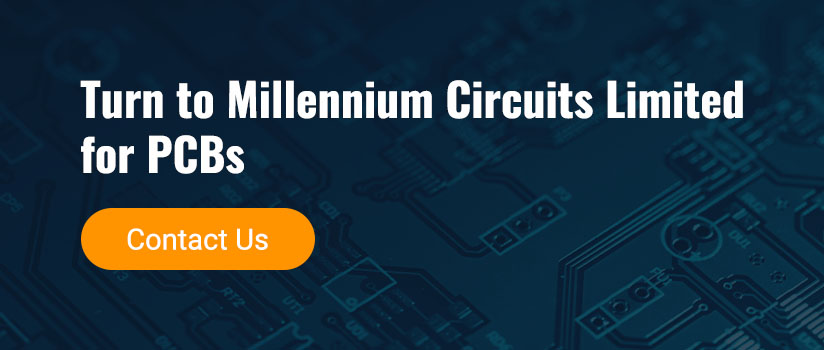Table of Contents:
- What Is Thermal Management?
- Why Thermal Management Is Important
- PCB Thermal Management Techniques
- Applications For PCB Thermal Management
Thermal management is one of the most critical factors of a printed circuit board’s (PCB) design. When a company wants their PCB to deliver excellent performance for a long time, they need to ensure it can dissipate heat effectively. Before you hire anyone to create your new PCBs, ensure they know some primary PCB thermal techniques. Using these techniques can ensure your PCB dissipates heat effectively and doesn’t experience performance drops due to excess heat.
Find out more about the importance of thermal management and some of the primary techniques for managing a PCB’s temperature.
What Is Thermal Management?
Thermal management refers to the practice of using materials to transfer heat away from parts to appropriate areas. When someone uses thermal management practices for PCBs, they’ll often transfer heat away from temperature-sensitive parts to components that can dissipate heat, such as thermal via arrays, heat sinks and heat pipes. Many thermal management techniques utilize heat transfer and thermodynamics to manage a PCB’s temperature.
Why Thermal Management Is Important
Due to the trend of miniaturizing modern devices, PCBs have had to get smaller too. Components are packed together more tightly in a PCB, resulting in more heat being generated per unit area. This excess heat can cause devices to malfunction, have performance issues and even fail if they don’t have proper thermal management.
A PCB’s performance is often measured in its durability, speed and accuracy. Excess heat in the PCB can negatively impact all of these measurements. As a result, thermal management is crucial for ensuring heat doesn’t impact the PCB’s performance.
PCB Thermal Management Techniques
Since heat can reduce your PCB’s performance, you may want to know some top PCB thermal management techniques to prevent excess heat. Many PCB designers utilize heat sinks, thermal via arrays and cooling fans for greater heat dissipation. They may also use thick copper traces and heat pipes in their thermal design of PCBs.
As you look to optimize your PCB for thermal management, consider these techniques to dissipate heat:
1. Heat Sinks
Heat sinks refer to metallic vias designed to conduct heat in a PCB. These metallic vias transfer heat throughout the PCB by conducting it from top layers to insulating layers. This process distributes the heat to a copper plane, allowing for heat dissipation. Usually, engineers attach heat sinks to heat-generating components like switching devices and power transistors. When you use these devices, you can expect them to transfer heat to the surroundings and dissipate heat over large areas.
2. Heat Pipes
When a PCB has limited space, heat pipes can be an excellent great choice for thermal management. They’re often used to assist compact devices, as they help with passive heat transfer. These pipes contain small amounts of ammonia, nitrogen, acetone or water to absorb heat. When the fluids absorb heat, they turn to vapor that gets sent down the pipe into a condenser. This condenser then condenses the vapor, turning it back into a liquid.
Once the vapor turns back into a liquid, the heat pipe can then restart the cycle, using the fluid again to absorb heat. Many companies use these pipes in PCBs, as they offer quiet and vibration-free operation due to the lack of moving parts. They’re also good at conducting thermal energy and don’t require much maintenance.
3. Cooling Fans
Another way to improve PCB thermal resistance is to employ cooling fans. By adding a cooling fan to a PCB, you can blow hot air out of an area, helping to prevent heat from building up. You’ll typically see cooling fans used for high current power supplies, as these fans assist with more comprehensive and faster heat removal.
4. Thermal Via Arrays
One of the main PCB thermal techniques is to utilize thermal via arrays. These thermal via arrays assist with proper heat conduction in the PCB. These devices work best when they’re closer to heat sources, as the proximity helps them dissipate heat faster and more efficiently. You can generally find two main types of thermal via arrays used in PCBs — simple vias and filled and capped vias. Simple vias are often a popular choice, as they significantly reduce the PCB’s thermal resistance.
However, filled and capped vias usually deliver greater performance since PCB designers can place them under a thermal solder pad. This placement lets them extract heat directly from the source. A filled and capped via also excels at heat dissipation due to its copper filling, as this filling prevents uncontrolled cavities and solder flow from occurring in the via during reflow soldering.
5. Thick Copper Traces
Thick copper traces can improve a PCB’s heat dissipation, as the addition of more copper allows the heat to dissipate over a larger surface area. Generally, companies use thick copper traces for high-power applications. They’ll also utilize thick traces to assist with cooling components featuring high thermal dissipation.
Applications for PCB Thermal Management
Many industries rely on PCBs for various devices and equipment, making PCB thermal management crucial. Here are some of the top applications for PCB thermal management in various industries:
- Automotive: You can find PCBs in many modern vehicles due to the increasing reliance on electronic and computerized systems. Thermal management techniques help the automotive industry ensure components like engine timing systems, airbag controls, climate control and anti-lock brake systems work properly and don’t overheat.
- Aerospace: Since planes regularly rely on PCBs and safety is paramount while flying, thermal management is crucial. You can find the aerospace industry using PCBs for computer software, radars and beepers, with thermal techniques crucial to ensuring these PCBs stay at the appropriate temperature for optimal performance.
- Medical: The medical industry relies on PCBs in various devices and equipment. Since these devices are used for potentially life-saving applications, they need to deliver reliable, exceptional performance. Thermal management techniques safeguard these devices from performance loss, making them an essential part of medical device design.
- Consumer electronics: Companies in the consumer electronics industry rely on PCBs to ensure their products work correctly. Some common consumer electronics that utilize PCBs include GPS units, smartphones, speakers, televisions and computers. PCB thermal resistance techniques help these products function properly and last for a long time.
Turn to Millennium Circuits Limited for PCBs
At Millennium Circuits Limited, we know how important it is for PCBs to dissipate heat. As a result, we ensure any PCBs we provide to our clients have an effective thermal design backing them up. When you turn to us for your PCB needs, we’ll use the best heat management techniques for your PCBs’ specific requirements and applications. When you need PCBs, we’ll be there to provide you with our PCB expertise every step of the way.
Take a moment to learn more about our PCB capabilities. If you want a free quote or need more information, please free to contact us.




